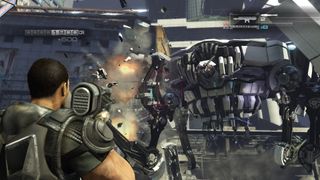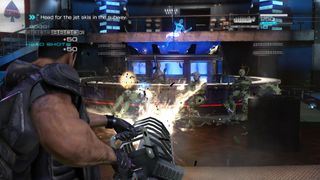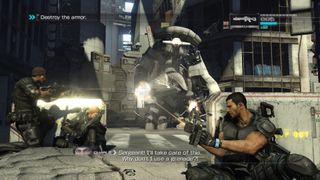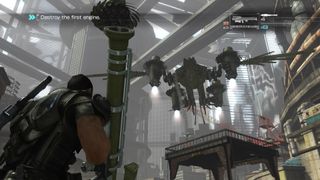We could try to shrug off Binary Domain for any number of reasons – we could say it just looks like a silly Gears clone, or we could claim its premise is just a rehash of the age old "sentient worker robots turn against humanity" seen in countless works of science fiction. It is a third-person cover shooter with a robot apocalypse story, but we're beginning to see that Binary Domain holds its own despite its initial appearance of unoriginality, presenting its own take on killer androids set against a striking backdrop of a dystopian future Tokyo.

Our last preview gave us a feel for the gameplay, and while pumping robots full of bullets still continued to impress us, this demo was much more focused on the story. One of the reasons why this type of robot/human conflict story is so overdone is that it's the perfect setting to explore all kinds of moral ambiguity, and it looks like binary Domain isn't passing on the opportunity to explore that here.
Our demo began with protagonist Dan and his partner Big Bo making their way through some slums, and it wasn't long before we got a sense that Binary Domain might be more seriously story-driven than we previously suspected. After blasting our way through a small army of robots, we came across a group of children salvaging scrap parts for money. Apparently kids have to grow up quickly in post-robocalyptic Tokyo, because they immediately drew their guns and fixed them upon us.

First, we were struck by the moral dilemma – what would you do if a kid pointed a gun at you, clearly intending to shoot? It's certainly an uncomfortable situation, especially when you're more than capable of firing back. The voice acting also stood out here – the kids spoke in native Japanese with subtitles instead of English. We've all heard our fair share of terrible accents in games, and while not all Tokyoites in Binary Domain speak in Japanese, the subtitled dialogue in this scene was a nice touch that definitely made it feel more authentic.
We didn't have too much time to weigh our choices though, because a nearby robot suddenly came to life and attacked the nearby children, forcing our squad to come to their defense and earning us a pass from the grateful urchins. As we continued on and entered Shibuya (or rather, the slum that people now refer to as Shibuya), we got a sense for how Yakuza Studios' expertise in world building, particularly given the Japanese setting, really sets Binary Domain apart.

The newly formed development studio is composed of the same people responsible for Sega's Yakuza series, so it's no surprise that the areas we saw of Tokyo felt exceptionally well-realized. Shibuya felt like a dystopian echo of its present-day namesake, with bright lights and cacophony on a much smaller scale, but still reminiscent of its former glory.
As we headed to speak to the big yakuza boss, Mifune, about safe passage through the city, we bore witness to a particularly intense scene of human-on-robot violence. A few gangsters had stumbled upon an injured man in the rumble, and to their surprise, saw his metallic skull through his head injury, revealing him to be a "hollow child," a robot made to look like a human. What made it disturbing was that as they pulled the sack off his head and kicked him to the ground, it became clear that the man begging for his life had absolutely no idea he wasn't human. It wasn't until he caught a glimpse of his injuries in one of the gang member's sunglasses that a glimmer of recognition – then horrified disbelief – fell across his face. We won't spoil how the entire scene played out, but it definitely left us wanting to see more of the world's inhabitants, both human and robot alike.

One of the big features also shown in the demo was the voice command system, where players can hold the left trigger button and then read one of several on-screen prompts to interact with squadmates and other NPCs. It's purely optional and it doesn't give any measurable gameplay advantage (you still need to hold down a button to use it, after all), but if you enjoy the novelty of shouting things like "Cover me!" into your headset, it might enrich your experience.
Our demo ended with a brief hands-on with each of Binary Domain's multiplayer modes: Team Deathmatch, Data Capture, and Domain Control. Deathmatch is pretty much what you'd expect, with five-on-five teams competing to rack up the most kills. Data Capture works like capture the flag, and Domain Control plays out on a linear map where opposing teams fight to gain control over checkpoints.

In all three modes, at the beginning of each round you can choose your character class (soldier, sniper, or scout, for example) and you get an allotment of points that you can allocate toward your loadout and extras like health packs, grenades and so forth. As you score points through kills and kill streaks, each time die you can re-equip more supplies as you wait to respawn, depending on how many points you've racked up. Each mode seemed fairly typical and straightforward, so the customization of your loadout is really what's going to set the multiplayer apart from what we can tell so far.
We were pleasantly surprised by how seriously the story and world is being taken in Binary Domain, especially given that it's a genre where those sorts of details often fall by the wayside, for better or for worse. And from what we've seen so far, the attention to the story hasn't come at the expense of the other gameplay elements either – cutting through waves of robots with a badass minigun was still one of the highlights of the demo. We can't wait to see everything that Binary Domain has in store, so look for more details as we approach its Valentine's Day release date.

